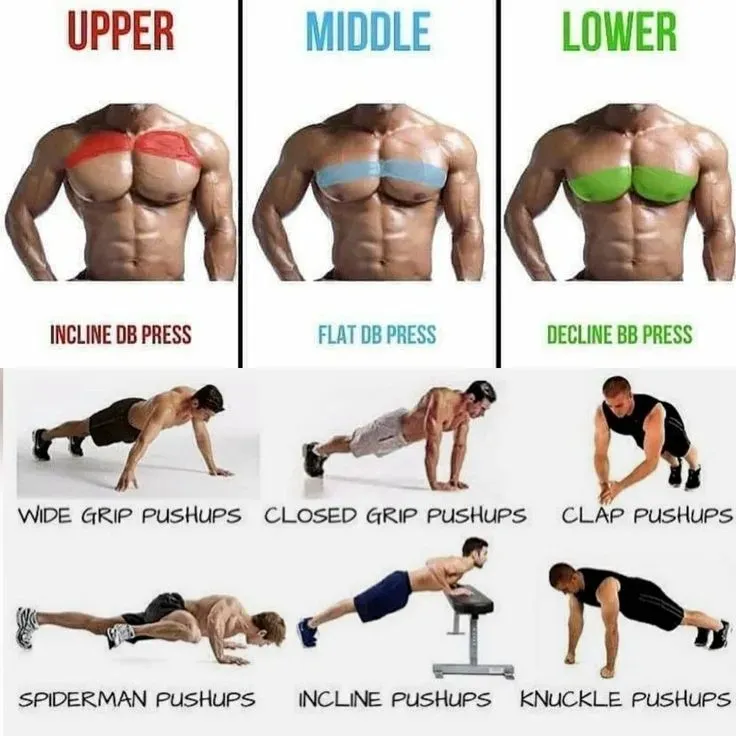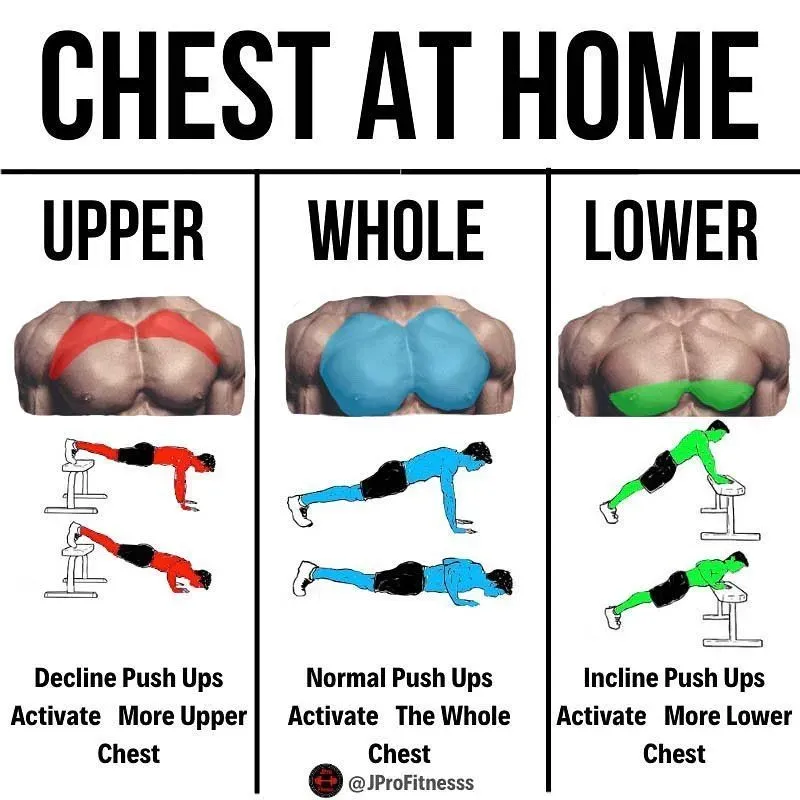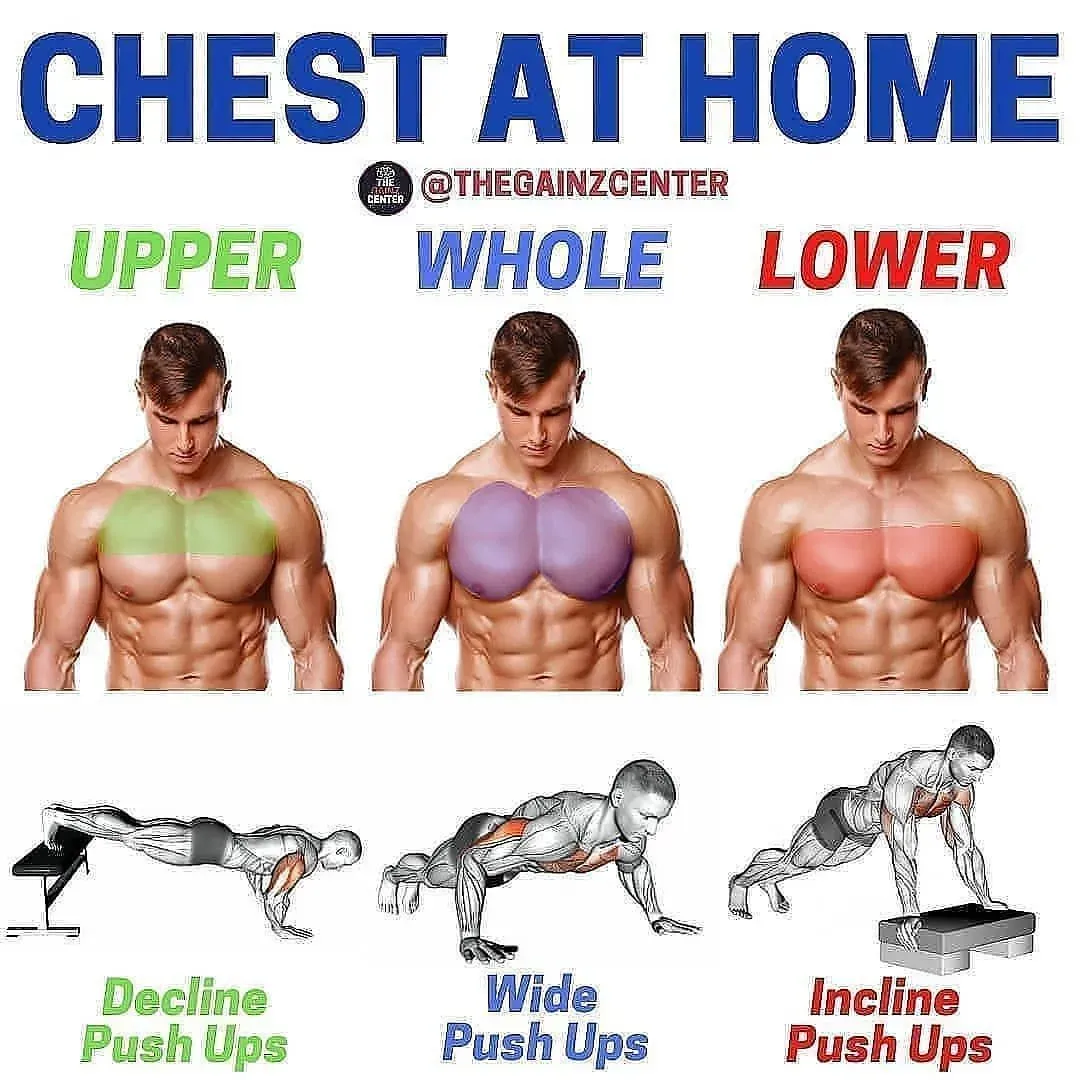Table of Contents
Thinking about building a solid chest without hitting the gym? You're not alone. A lot of people start with the basic push up, figuring that's all there is to a chest workout at home. And while the classic push up is a fundamental move, just doing a few sets of the same old thing might leave you feeling... well, underwhelmed and maybe a little sore in your shoulders instead of your chest.
Why Your Standard Push Ups Aren't Cutting It for a Full Chest Workout at Home

Why Your Standard Push Ups Aren't Cutting It for a Full Chest Workout at Home
The Problem with Repetition
Look, the classic push up is fine as a starting point.
It hits your chest, shoulders, and triceps, sure.
But relying solely on the standard version for your entire chest workout at home? That's like trying to build a whole house with just a hammer.
Your muscles are smart, and frankly, a bit lazy.
They adapt quickly to the same movement pattern and resistance.
After a few weeks, doing standard push ups becomes less about building new muscle and more about endurance.
You can crank out more reps, but are you actually getting stronger or bigger in your chest?
Probably not as much as you could be.
You're leaving a lot of potential gains on the table by not challenging your chest in different ways.
Neglecting Angles and Activation
Your chest, or pectoralis major, is a large muscle with different fibers that respond best to varied angles and stimuli.
A flat, standard push up primarily targets the middle part of your pecs.
It doesn't do much for the upper chest (clavicular head) or the lower chest (sternal head).
Think about it: when you use barbells or dumbbells, you do incline presses, decline presses, and flat presses to hit everything.
Just doing standard push ups for your chest workout at home ignores these crucial angles.
You might develop decent middle pec strength but leave the upper and lower parts lagging, leading to an unbalanced look and potentially limiting overall strength.
An effective chest workout at home push ups plan needs to address this.
What are you hoping to get from your chest workout at home push ups?
- Build overall chest mass?
- Increase pushing strength?
- Improve muscle definition?
- Just avoid the gym?
Targeting Your Pecs: Essential Push Up Variations for a Killer Chest Workout at Home

Targeting Your Pecs: Essential Push Up Variations for a Killer Chest Workout at Home
Hit Your Upper and Lower Pecs with Angle Play
so the standard push up hits the middle chest, right? To build a truly balanced physique with your chest workout at home push ups, you need to mess with the angles.
Think about incline and decline presses in the gym. You can replicate that effect using push ups.
To target your lower chest, you'll want to do incline push ups. Find a sturdy elevated surface – a chair, a coffee table, the edge of your couch.
Place your hands on the elevated surface and perform your push ups. The higher the surface, the easier it is and the more it shifts focus to the lower pecs.
Conversely, to hammer that often-neglected upper chest, you need decline push ups. This time, elevate your feet on that same sturdy surface.
Hands are on the floor, feet are up. This is significantly harder and puts more emphasis on the upper chest fibers.
Mastering these two variations is non-negotiable for a comprehensive chest workout at home push ups routine.
Widen Your Grip, Narrow Your Focus
Angle variations aren't the only trick up your sleeve for a solid chest workout at home push ups.
You can also change your hand position to hit different areas and increase difficulty.
A wider grip push up, with your hands placed wider than shoulder-width apart, puts more stress on the outer part of your chest.
It helps build that sense of width.
On the flip side, a narrow grip or diamond push up (where your index fingers and thumbs touch, forming a diamond shape under your chest) intensely targets the inner chest and triceps.
These require more stability and strength, making them excellent for progression.
Incorporating both wide and narrow variations ensures you're working your pecs across their full range and challenging them in new ways.
Ready to try some variations?
- Incline Push Ups (Hands on elevated surface)
- Decline Push Ups (Feet on elevated surface)
- Wide Grip Push Ups (Hands wider than shoulders)
- Diamond Push Ups (Hands close, fingers and thumbs touching)
- Archer Push Ups (Advanced, shifting weight to one side)
Beyond the Basics: How to Structure Your Chest Workout at Home with Push Ups
Putting the Variations Together
so you've got your incline, decline, wide, and diamond push ups ready to go.
Now, how do you string these together into an actual chest workout at home push ups routine that makes sense and delivers results?
You wouldn't just randomly pick exercises at the gym, right?
The key is variety and progression.
Think about hitting different angles and levels of difficulty within a single session or across your training week.
A solid approach involves selecting 3-5 variations and performing them in a sequence that allows for adequate recovery between sets while still challenging your muscles.
You could start with a compound, heavier variation like decline push ups, move to a middle-range like wide grip, and finish with an isolation-style move like diamond push ups to really burn out the inner chest and triceps.
The order matters, just like stacking exercises in a gym routine.
How do you decide which variations to include in your routine today?
Common Mistakes Ruining Your Chest Workout at Home Push Ups (And How to Fix Them)

Common Mistakes Ruining Your Chest Workout at Home Push Ups (And How to Fix Them)
Sacrificing Form for Reps
let's be real. We've all seen it, maybe even done it. That frantic set of push ups where your hips sag, your head juts forward, and the range of motion is about two inches.
You think you're crushing it because the rep count is high, but you're mostly just flailing.
This isn't a chest workout at home push ups session; it's an injury waiting to happen and a guaranteed way to get zero actual chest development.
Muscles respond to tension and controlled movement, not jerky, half-hearted bounces.
Focus on keeping a straight line from your head to your heels, engaging your core, and going all the way down until your chest is close to the floor (or as far as your mobility allows with good form), and pushing all the way back up, fully extending your arms without locking out.
Quality over quantity, always. Fifty ugly push ups do less for your chest than fifteen perfect ones.
Ignoring Time Under Tension
Another classic blunder in the chest workout at home push ups game? Rushing the reps.
Slamming down and springing back up like you're on a pogo stick might feel fast, but it robs your muscles of valuable time under tension.
That controlled negative (the lowering phase) is crucial for muscle breakdown and growth.
If you just drop, you're missing half the exercise and half the potential results.
Try lowering yourself slowly, maybe taking 2-3 seconds to reach the bottom.
Pause briefly at the bottom, feeling the stretch in your chest.
Then, explode back up. This simple tweak dramatically increases the effectiveness of each push up and makes your chest workout at home push ups sessions far more productive.
Mistake | Impact | The Fix |
|---|---|---|
Bad Form (Sagging hips, half reps) | Poor muscle activation, potential injury | Maintain straight body line, full range of motion |
Rushing Reps | Reduced time under tension, less muscle growth | Control the descent (2-3 secs), pause at bottom |
Doing Only One Variation | Neglects parts of the chest, plateaus quickly | Incorporate incline, decline, wide, and diamond variations |
Forgetting to Progress
So you can do 3 sets of 20 standard push ups no problem. Great. Now what?
If you keep doing the exact same thing, your chest workout at home push ups routine stops being a challenge and starts being maintenance.
Muscles grow when they are forced to adapt to something harder than they're used to.
This is where progression comes in. It's the entire point of getting stronger.
Progression doesn't just mean adding more reps, although that's one way.
It means moving to harder variations (like from incline to flat, or flat to decline), increasing the time under tension, adding pauses, reducing rest time between sets, or even trying single-arm variations down the line.
If your chest workout at home push ups aren't getting harder over time, you're not giving your chest a reason to grow.
Making Progress: Frequency, Form, and Feeling the Burn with Your Chest Workout at Home Push Ups

Making Progress: Frequency, Form, and Feeling the Burn with Your Chest Workout at Home Push Ups
How Often Should You Hit Your Chest Workout at Home Push Ups?
Alright, you've got the variations down, you're fixing your form, and you're ready to make real progress with your chest workout at home push ups. The next question is, how often should you be doing this?
Your muscles don't grow *during* the workout; they grow when you're resting and recovering.
Hammering your chest with push ups every single day is usually counterproductive.
It doesn't give your muscle fibers time to repair and get stronger.
For most people, hitting the chest 2-3 times per week is plenty.
This allows for adequate recovery time between sessions.
Listen to your body though. If you're still really sore from your last chest workout at home push ups, maybe take an extra day off or do a lighter session focusing purely on perfect form or easier variations.
Consistency over intensity is the key here.
Why Perfect Form Trumps Everything in Your Chest Workout at Home Push Ups
We touched on form mistakes earlier, but it's worth repeating: form is king.
Seriously, I'd rather see someone do five perfect push ups than twenty sloppy ones that look like a fish flopping on a boat deck.
Perfect form ensures you're actually targeting the chest muscles you intend to work.
It also drastically reduces your risk of shoulder or wrist injury, which can sideline your chest workout at home push ups for weeks.
Think about the path your hands take, keeping your elbows at about a 45-degree angle relative to your body (not flared straight out like wings), and maintaining that rigid plank position from head to heels.
Record yourself if you can. It's often eye-opening to see what you *think* your form looks like versus reality.
Quick Form Checklist:
- Hands slightly wider than shoulder-width, fingers pointing forward.
- Body forms a straight line from head to heels (no sagging hips or piking butts).
- Core and glutes are tight.
- Lower chest towards the floor, keeping elbows tucked slightly (45 degrees).
- Go as low as possible with good form, ideally chest close to the floor.
- Push through your palms, engaging your chest to return to the start.
- Control the movement, especially the lowering phase.
Feeling the Burn: Connecting Your Mind to Your Muscles
This is where the magic happens and turns a generic pushing exercise into a focused chest workout at home push ups session.
It's called the mind-muscle connection, and it's not some woo-woo concept.
It's about consciously thinking about the muscles you're supposed to be working – your pecs – and actively squeezing them throughout the movement.
As you lower down, feel the stretch across your chest.
As you push up, focus on contracting your chest muscles to drive the movement, rather than just using your arms and shoulders.
Try flexing your pecs hard at the top of each rep for a second.
This deliberate focus increases muscle activation and can lead to better results, even if you're doing fewer reps than someone just going through the motions.
It takes practice, but learning to feel your chest working during every single rep of your chest workout at home push ups is a game-changer for progress.
Your Chest, Rebuilt at Home
So, there you have it. Turning basic push ups into a serious chest-building tool at home isn't some fitness guru secret; it's about smart application of variation, understanding leverage, and honestly, putting in the consistent work. Ditching the gym doesn't mean ditching the gains, but it does mean you have to be more strategic with your bodyweight movements. Stop doing the same flat push up set after set and expecting miracles. Mix it up, focus on form over speed, and pay attention to what your chest is actually feeling. It might not be glamorous like bench pressing heavy iron, but a well-executed at-home push up routine can absolutely sculpt a chest you'll be happy with. Now, drop and give me... well, you know.
